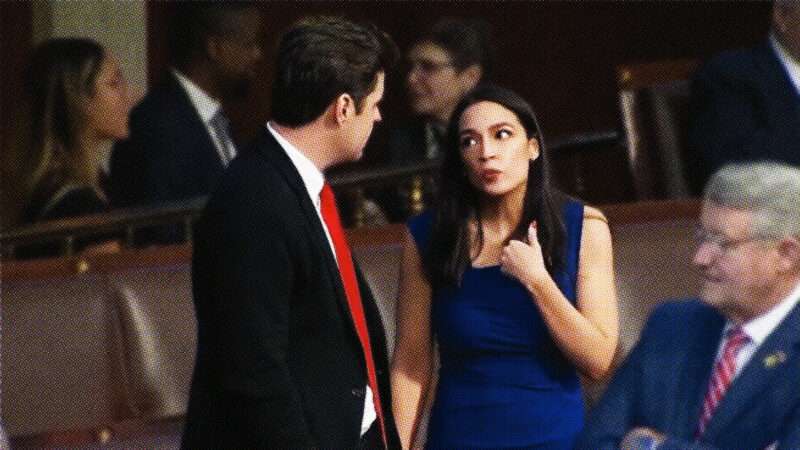
The U.S. House of Representatives has struggled all week to elect a new speaker. Rep. Kevin McCarthy (R–Calif.), the presumptive frontrunner, has so far lost over a dozen separate votes as he struggles to win over dissenters in his own party.
During what should otherwise be a completely routine and unexceptional parliamentary procedure, viewers are glued to C-SPAN, the nonprofit cable channel that has aired live, unedited footage from the House floor since 1979. The proceedings have even produced viral moments: Newly-elected congressman and serial fabulist George Santos (R–N.Y.) sitting alone in the House chamber. Children, tired and bored, waiting for their parents to finish.
In two other separate videos, Rep. Alexandria Ocasio-Cortez (D–N.Y.) spoke privately with far-right Reps. Paul Gosar (R–Ariz.) and Matt Gaetz (R–Fla.), her presumptive ideological opposites. The video of Gaetz and Ocasio-Cortez prompted speculation as to what the two were discussing; when The Intercept's Ryan Grim asked her, Ocasio-Cortez said that the two were discussing a "side deal" that McCarthy allegedly tried to strike with some Democrats.
If this week feels unusually exciting for the typically staid C-SPAN, there's a reason for that. Ben O'Connell, C-SPAN's director of editorial operations, told VICE that private video cameras are usually not allowed in the U.S. House. The House Recording Studio, a government entity, controls all cameras in the chamber and allows C-SPAN and others to broadcast the footage it captures. Many times over four decades, C-SPAN asked for permission to add its own cameras to the chamber, and each time the House denied the request.
But C-SPAN is allowed to bring in its own cameras during certain high-profile events, like swearing-in ceremonies or the State of the Union. Since the House speaker vote is one of those events, and it has stretched on for several days, the cameras have been able to stay and capture candid moments between members that would otherwise not be seen by anybody not physically present.
In practice, there are strict rules on what the House's own cameras may cover, only showing the member speaking or a wide shot of the dais. In the past, any deviations from that format proved controversial: Then-Rep. Newt Gingrich (R–Ga.), who joined Congress the same year C-SPAN debuted, routinely gave speeches after House business had concluded, for the benefit of the viewing audience at home. In 1984, then-Speaker Thomas "Tip" O'Neill (D–Mass.) ordered the cameras to cut away and show that Gingrich was addressing an empty chamber. The incident later led to a contentious debate on the House floor.
In fact, government officials often resist openness: Even though C-SPAN started showing House proceedings in 1979, the Senate did not assent until 1986. The Supreme Court still does not allow video or even photographs of its oral arguments; it took the COVID-19 pandemic for the Court to finally offer livestreaming audio rather than simply transcripts and recordings after the fact.
The benefits of more openness are apparent this week in the House: Elected representatives earning a taxpayer-funded salary should be doing their business in as open a manner as possible. That not only includes their public speeches but what they do when they're not speaking into a microphone.
We only know about Gaetz and Ocasio-Cortez's private confab because it took place while C-SPAN was allowed in; that few seconds on air led to widespread speculation, which prompted journalists to look into it and learn more information about McCarthy's wheeling-and-dealing behind closed doors. Without the special permission granted for the event, the American public would not have known about any of it.
More openness in government is a good thing, even (and especially) when government officials resist it. After a new speaker is elected, he or she should allow the new cameras to stay.
The post Cameras Should Stay in Place After the House Picks a Speaker appeared first on Reason.com.







